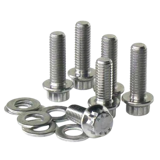They are widely employed in industries like construction, automotive, marine, and manufacturing, where durability, resistance to rust, and strength are crucial. These fasteners are ideal for environments exposed to moisture, chemicals, or high temperatures.
-
Material Composition:
- Stainless Steel: An alloy of steel containing a minimum of 10.5% chromium, which provides resistance to corrosion and oxidation. Common grades include 304 and 316 stainless steel.
- Chromium: The addition of chromium forms a passive layer on the surface of the fastener, which protects against rust and corrosion.
- Molybdenum (in some grades): Enhances resistance to pitting and corrosion in more aggressive environments, such as marine settings.
-
Types of Stainless Steel Fasteners:
- Bolts: Threaded fasteners designed to work with a nut or in a tapped hole.
- Screws: Fasteners with a helical ridge, used in pre-drilled holes or for threading into materials.
- Nuts: Used with bolts to secure two or more components together.
- Washers: Distribute load and prevent damage to the surface of the material being fastened.
- Threaded Rods: Long, continuous-thread fasteners, used when a longer length of thread is required.
- Rivets: Non-threaded fasteners used to join two surfaces permanently.
-
Grades:
- 304 Stainless Steel: Known for good corrosion resistance, commonly used in general applications like furniture, fixtures, and light construction.
- 316 Stainless Steel: Contains molybdenum, offering enhanced corrosion resistance, especially in saltwater or chemical-rich environments, making it ideal for marine or industrial applications.
- 410 Stainless Steel: Hardened steel with good tensile strength, used in applications requiring extra durability but less corrosion resistance.
-
Applications:
- Marine: Ideal for use in boats, docks, and underwater applications due to their high resistance to saltwater corrosion.
- Construction: Widely used in the building of bridges, skyscrapers, and other structures where longevity and corrosion resistance are necessary.
- Automotive: Used in engine components, exhaust systems, and other parts exposed to heat, moisture, and road chemicals.
- Aerospace: Critical for applications that demand both strength and resistance to extreme environments.
- Manufacturing: Essential in industrial machinery, tools, and equipment that must withstand harsh conditions.
- Food Processing: Used in food preparation equipment due to their resistance to corrosion, ease of cleaning, and non-reactivity with food materials.
-
Advantages:
- Corrosion Resistance: Offers excellent protection against rust, oxidation, and other types of corrosion, making them suitable for outdoor and harsh environments.
- Strength and Durability: High tensile strength and durability ensure secure connections that can withstand stress, vibration, and pressure.
- Temperature Resistance: Performs well in high-temperature environments without losing structural integrity.
- Aesthetic Appeal: Has a polished, shiny appearance, making it a preferred choice for architectural projects and visible applications.
- Long Lifespan: Provides a long-lasting solution with minimal maintenance required, reducing long-term costs.
-
Challenges:
- Cost: More expensive than carbon steel or alloy steel fasteners due to the material composition.
- Galling: Stainless steel fasteners are prone to galling (a form of wear caused by adhesion) when tightened, especially without lubrication.
- Hardness: Not as hard as carbon steel, which can be a drawback in high-load applications requiring extreme hardness.




![Sanding Sheets Abrasives [MSMEs]](/content/images/thumbnails/1078_160_sanding-sheets-abrasives-msmes-_.png)
![Flap Discs Abrasives [MSMEs]](/content/images/thumbnails/1080_160_flap-discs-abrasives-msmes-_.png)
![Sanding Belts Abrasives [MSMEs]](/content/images/thumbnails/1081_160_sanding-belts-abrasives-msmes-_.png)
0 Comment
Leave a Comment